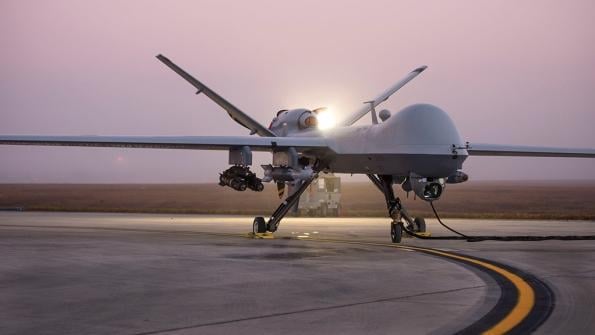
General Atomics Aeronautical Systems debuted its MQ-9 Block 5 Ghost Reaper concept at the U.S. Air Force’s largest trade show, rebranding the counterinsurgency platform to fit the service’s vision for the Advanced Battle Management System (ABMS).
ABMS is the Air Force’s answer to Joint All-Domain Command and Control (JADC2), which is the Pentagon’s concept for all the military services—Air Force, Army, Marine Corps, Navy and Space Force—to connect sensors into a single network.
The Pentagon says military personnel will use JADC2, which is similar to ridesharing applications. Ridesharing services combine two different applications, the first for riders and the second for drivers. Those applications use an algorithm that determines the best match based on distance, travel time, passengers and other variables. JADC2 will share intelligence, surveillance and reconnaissance data over numerous communications networks to accelerate the decision-making process. Once the data is collected, artificial intelligence algorithms will identify targets and recommend the best kinetic and non-kinetic weapon to use on the target.
The MQ-9 is associated with the Pentagon’s counterinsurgency efforts in the Middle East. General Atomics is looking to rebrand the platform to fit into the JADC2 construct. The company’s ad shows the Ghost Reaper as a node to connect fourth- and fifth-generation aircraft. The upgraded aircraft features a Northrop Grumman Freedom Pod with infrared search and track and Freedom 550 to connect the military services, Ultra Electronics Rosetta Echo Advanced Payload (REAP) for advanced networking and data sharing, onboard high-powered computing, aircraft survivability pylons for self-protection, and a detect-and-avoid system for self-separation and weather avoidance.
The Ghost Reaper concept falls in line with the Air Force plan to use the MQ-9 as an attritable aircraft that the military can afford to lose in a war with China or Russia.
The Air National Guard and Air Force Reserve Command Test Center conducted a two-week test in Syracuse, New York, that involved installing REAP on the MQ-9’s outer wing that provides communication range extension, voice repeater, relay functions, data exchange and translation across various radio networks.
“What we were able to accomplish in Syracuse was actually proving with another system that range extension and bridging actually does work,” Jeff Lloyd-Jones, strategic development vice president at Ultra, told Aerospace DAILY. “We were able to characterize about 10 times the range of a typical line-of-sight communication.”
REAP bridged surveillance imagery video from a Coyote unmanned aircraft system (UAS) to ground command-and-control assets. Follow-on versions of REAP include Link 16 integration, providing low-latency tactical data link information to military personnel in the air and on the ground. This new capability would allow the Joint Terminal Attack Controller to designate an attack aircraft to hit a target.
The MQ-9 also played a role during the Air Force’s second ABMS Onramp, held Aug. 31-Sept. 3. A Reaper assigned to the 556th Test and Evaluation Sqdn. employed a live-fire air-to-air AIM-9X Block 2 missile against a target BQM-167 UAS simulating a cruise missile.
The crew received off-board cueing information, found and tracked the target, and fired the AIM-9X against the surrogate cruise missile.
“While early in development, this successful test opens the door to further explore integration opportunities the aircraft and cockpit could provide to JADC2, as well as counter-air capabilities and roles beyond the typical counterterrorism roles assumed by the MQ-9,” Lt. Col. Michael Chmielewski, 556th Test and Evaluation Sqdn. commander, said in a statement.
